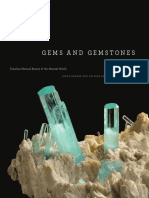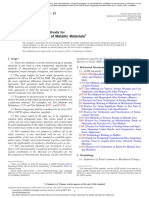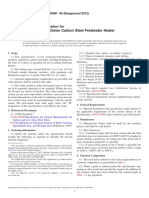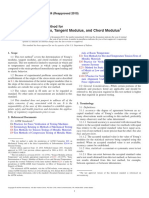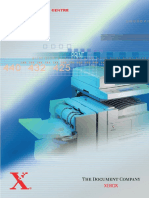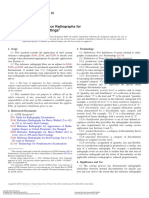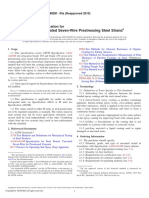Stainless Chromium-Nickel Steel-Clad Plate: Standard Specification For
Stainless Chromium-Nickel Steel-Clad Plate: Standard Specification For
Uploaded by
Sama UmateCopyright:
Available Formats
Stainless Chromium-Nickel Steel-Clad Plate: Standard Specification For
Stainless Chromium-Nickel Steel-Clad Plate: Standard Specification For
Uploaded by
Sama UmateOriginal Title
Copyright
Available Formats
Share this document
Did you find this document useful?
Is this content inappropriate?
Copyright:
Available Formats
Stainless Chromium-Nickel Steel-Clad Plate: Standard Specification For
Stainless Chromium-Nickel Steel-Clad Plate: Standard Specification For
Uploaded by
Sama UmateCopyright:
Available Formats
Designation: A264 − 12
Standard Specification for
Stainless Chromium-Nickel Steel-Clad Plate1
This standard is issued under the fixed designation A264; the number immediately following the designation indicates the year of
original adoption or, in the case of revision, the year of last revision. A number in parentheses indicates the year of last reapproval. A
superscript epsilon (´) indicates an editorial change since the last revision or reapproval.
This standard has been approved for use by agencies of the U.S. Department of Defense.
1. Scope* 2.2 Other Standards:
2
1.1 This specification covers plate of a carbon steel or ASME Boiler and Pressure Vessel Code, Section IX4
low-alloy steel base to which is integrally and continuously
3. Terminology
bonded on one or both sides a layer of stainless chromium-
nickel steel. The material is generally intended for pressure 3.1 Definitions of Terms Specific to This Standard:
vessel use. 3.1.1 This material is considered as single-clad or double-
clad corrosion-resisting chromium-nickel steel plate, depend-
1.2 The values stated in inch-pound units are to be regarded
ing on whether one or both sides are covered.
as standard. The values given in parentheses are mathematical
3.1.2 alloy cladding—the stainless chromium-nickel steel
conversions to SI units that are provided for information only
component of the composite plate.
and are not considered standard.
3.1.3 base metal (backing steel)—component to which the
2. Referenced Documents alloy cladding is applied, usually the greater percentage of the
2.1 ASTM Standards:3 composite plate and usually consisting of carbon or low-alloy
A6/A6M Specification for General Requirements for Rolled steel.
Structural Steel Bars, Plates, Shapes, and Sheet Piling 3.1.4 integrally and continuously bonded—the process by
A20/A20M Specification for General Requirements for Steel which the alloy cladding and base metal are brought together to
Plates for Pressure Vessels form a metallurgical bond at essentially the entire interface of
A240/A240M Specification for Chromium and Chromium- the two metals by means other than those processes that do not
Nickel Stainless Steel Plate, Sheet, and Strip for Pressure produce a homogeneous composite plate.
Vessels and for General Applications
A370 Test Methods and Definitions for Mechanical Testing 4. Ordering Information
of Steel Products 4.1 It is the responsibility of the purchaser to specify all
A480/A480M Specification for General Requirements for requirements that are necessary for material ordered under this
Flat-Rolled Stainless and Heat-Resisting Steel Plate, specification. Such requirements may include, but are not
Sheet, and Strip limited to, the following:
A578/A578M Specification for Straight-Beam Ultrasonic 4.1.1 Quantity (weight or number of pieces).
Examination of Rolled Steel Plates for Special Applica- 4.1.2 Cladding alloy specification, (UNS or ASTM Specifi-
tions cation A240/A240M and whether cladding is for corrosion
A751 Test Methods, Practices, and Terminology for Chemi- allowance only),
cal Analysis of Steel Products 4.1.3 Base metal specification.
4.1.4 Bond integrity Class (1, 3, or 5).
4.1.5 Dimensions including the minimum or nominal thick-
1
ness of the cladding alloy, and the backing steel, or of the total
This specification is under the jurisdiction of ASTM Committee A01 on Steel,
Stainless Steel and Related Alloys and is the direct responsibility of Subcommittee
composite plate and if more or less restrictive thickness
A01.11 on Steel Plates for Boilers and Pressure Vessels. tolerances apply.
Current edition approved Nov. 1, 2012. Published November 2012. Originally 4.1.6 Product analysis, if required (see Section 10). Specify
approved in 1943. Last previous edition approved in 2011 as A264 – 11. DOI: whether applicable to the cladding alloy, backing steel or both.
10.1520/A0264-12.
2
For ASME Boiler and Pressure Vessel Code applications see related Specifi- 4.1.7 Mechanical properties, including shear test if required.
cation SA-264 in Section II of that Code.
3
For referenced ASTM standards, visit the ASTM website, www.astm.org, or
4
contact ASTM Customer Service at service@astm.org. For Annual Book of ASTM Available from American Society of Mechanical Engineers (ASME), ASME
Standards volume information, refer to the standard’s Document Summary page on International Headquarters, Two Park Ave., New York, NY 10016-5990, http://
the ASTM website. www.asme.org.
*A Summary of Changes section appears at the end of this standard
Copyright © ASTM International, 100 Barr Harbor Drive, PO Box C700, West Conshohocken, PA 19428-2959. United States
Copyright by ASTM Int'l (all rights reserved); 1
A264 − 12
4.1.8 Finish (see Section 12). 5.2.3 When plates are to be cold formed, or when otherwise
4.1.9 Restrictions, if required, on repair by welding (see required by the base metal specification, the purchaser may
Section 14). specify that such plates, following solution annealing, be heat
4.1.10 Additions to the specification or special requirements treated for grain refinement of the base metal by normalizing
such as any applicable construction code rules. and either air cooled or water quenched as appropriate.
4.1.11 Corrosion testing if applicable. 6. Chemical Composition
4.1.12 Notification when the cladding alloy is to be used for
inclusion in the design strength calculations for an applicable 6.1 The composite plate may conform to any desired com-
construction code. bination of alloy-cladding metal and base metal as described in
6.2 and 6.3 and as agreed upon between the purchaser and the
NOTE 1—Construction codes may dictate certain fabrication require- manufacturer.
ments when the cladding is used in the design calculations that may be
different than if the cladding is used for corrosion resistance only. This 6.2 Alloy Cladding Metal—The alloy-cladding metal speci-
may be particularly important when the alloy cladding involves the use of fied shall conform to the requirements as to chemical compo-
welded components in the explosion bonded clad manufacturing process. sition prescribed for the respective chromium-nickel or duplex
It is incumbent on the purchaser to make the clad manufacturer aware of
any such restrictions or applications at time of order.
steel in Specification A240/A240M.
4.2 In addition to the basic requirements of this specification 6.3 Base Metal—The base metal shall be carbon steel or
and the backing steel specification, certain supplementary low-alloy steel conforming to the ASTM specifications for
requirements are available when additional control, testing, or steel for pressure vessels, or other, as agreed by the purchaser
examination is required to meet end use requirements. The and the manufacturer. The base metal shall conform to the
purchaser is referred to the listed supplementary requirements chemical requirements of the specification to which it is
in this specification and to the detailed requirements in ordered.
Specification A20/A20M. 7. Mechanical Properties
4.3 If the requirements of this specification are in conflict 7.1 Tensile Requirements:
with the requirements of Specification A20/A20M, the require- 7.1.1 The tensile properties shall be determined by a
ments of this specification shall prevail. tension test of the composite plate for clad plates that meet all
4.4 Special tests. of the following conditions.
(1) The composite gage is less than or equal to 11⁄2 in. (38
5. Materials and Manufacture mm).
(2) The specified minimum tensile strength of the base
5.1 Process: steel is less than or equal to 70 000 psi (485 MPa)
5.1.1 The steel shall be made by the open-hearth, electric- (3) The specified minimum yield strength of the base steel
furnace, or basic-oxygen processes, or by secondary processes is less than or equal to 40 000 psi (275 MPa).
whereby steel made from these primary processes is remelted (4) The tensile properties thus determined shall be not less
using, but not limited to electroslag remelting or vacuum-arc than the minimum and not more than 5000 psi (35 MPa) over
remelting processes. the maximum prescribed in the specification for the base steel
5.1.2 The alloy-cladding metal may be metallurgically used. All other tensile test requirements of the specification for
bonded to the base metal by any method that will produce a the base steel shall be met.
clad steel that will conform to the requirements of this 7.1.2 The tensile properties shall be determined by a
specification. tension test of the base steel only for clad plates that meet one
5.1.3 For explosively bonded products, the alloy cladding of the following conditions. The properties thus determined
metal may be comprised of two or more separate alloy plates shall meet all of the tensile test requirements for the base steel.
or sheets completely welded together to form a single fabri- (1) The composite gage is greater than 11⁄2 in. (38 mm).
cated component. (2) The specified minimum tensile strength of the base
5.2 Heat Treatment: steel is greater than 70 000 psi (485 MPa).
5.2.1 Unless otherwise specified or agreed upon between (3) The specified minimum yield strength of the base steel
the purchaser and the manufacturer, all austenitic stainless steel is greater than 40 000 psi (275 MPa).
clad plates shall be given a heat treatment consisting of heating 7.1.3 If the cladding is for corrosion allowance only, the
to the proper temperature for the solution of the chromium cladding need not be included in the tensile test. The tensile
carbides in the cladding followed by individual air cooling. For properties thus determined shall meet the base steel require-
base metals of air-hardening low-alloy steels the above heat ments.
treatment shall be followed by a tempering treatment. In the 7.2 Tests for strength of the bond, when required, must be
case of clad plate manufactured without hot rolling, the base specified by the purchaser and shall consist of one of the
metal and alloy cladding components may be heat treated following.
separately as appropriate prior to bonding. 7.2.1 Shear Strength—When required by the purchaser, the
5.2.2 Duplex stainless steel clad plates shall be provided in minimum shear strength of the alloy cladding and base metals
a heat treated condition as agreed upon between the purchaser shall be 20 000 psi (140 MPa). The shear test, when specified,
and the manufacturer. shall be made in the manner indicated in Fig. 1. The minimum
Copyright by ASTM Int'l (all rights reserved); 2
A264 − 12
the tension tests indicated in Fig. 2 and shall be bent through an
angle of 180° to the bend diameters provided for in either
Specification A6/A6M or Specification A20/A20M, Appendix
X4 or equivalent, as applicable. At least two of the three tests
shall show not more than 50 % separation on both edges of the
bent portion. Greater separation shall be cause for rejection.
7.3 Methods and practices relating to mechanical testing
required by this specification shall be in accordance with the
Test Methods and Definitions of A370.
8. Number of Tests and Retests
8.1 One or more tension tests, as required by the specifica-
tions for the base metal and when specified, one shear test or
three bond bend tests shall be made, representing each plate as
rolled. Each specimen shall be in the final condition of heat
Metric Equivalents treatment required for the plate, including any SPWHT if
in. mm in. mm required.
0.005 0.127 1 25.4
1⁄ 8 3.18 21⁄2 64.5 8.2 If any test specimen shows defective machining or
3⁄ 4 19.1 3 76.2 develops flaws, it may be discarded and another specimen
substituted.
FIG. 1 Test Specimen and Method of Making Shear Test of Clad
Plate 9. Test Specimens
9.1 The tension test specimens from plate shall conform to
cladding thickness for shear testing shall be 0.075 in. (1.9 mm), the requirements prescribed in the specifications for the base
exclusive as ordered. Testing for shear strength for clad plates metal.
with minimum cladding thickness of 0.075 in. (1.9 mm) or less 9.2 Bend test specimens for the alternative bond strength
shall be permitted upon agreement between the purchaser and tests, shall be taken at right angles to its longitudinal axis.
the manufacturer.
7.2.2 Bond Strength—As an alternative to the shear strength 9.3 When required by the purchaser, the shear test specimen
test provided in 7.2.1, or when agreed upon by the purchaser should be taken near a top or bottom corner of the plate as
and the manufacturer, or both, three bend tests shall be made rolled, parallel to its longitudinal axis, or other location that is
with the alloy cladding in compression to determine the quality representative of the final product.
of the bond. These bend tests shall be made in the manner of 9.4 For plates 11⁄2 in. (38 mm) and under in thickness,
tension test specimens shall be the full thickness of the
material, except as specified in 7.1.2 and 7.1.3.
9.5 For plates over 11⁄2 in. (38 mm) in thickness, tension
tests shall be of the form shown in Fig. 3 and shall be of all
base steel conforming to the requirements of the specification
for the base steel.
9.6 The bend test specimen used for bond strength determi-
nation shall be 11⁄2 in. (38 mm) wide by not more than 3⁄4 in.
(19 mm) in thickness and shall be machined to the form and
Metric Equivalents dimensions shown in Fig. 2, or may be machined with both
edges parallel. In reducing the thickness of the specimen, both
in. mm in. mm
the alloy cladding and the base steel shall be machined so as to
0.01 0.254 11⁄2 38.1
1⁄ 8 3.17 2 50.8 maintain the same ratio of clad metal to base steel as is
1⁄ 4 6.35 3 76.2 maintained in the plate, except that the thickness of the clad
1 25.4 8 203.2 metal need not be reduced below 1⁄8 in. (3.1 mm). The sides of
NOTE 1—When necessary, it is permissible to use a narrower specimen,
the bend test specimen used for bond strength determination
but in such a case the reduced portion shall be not less than 1 in. in width. may have the corners rounded to a radius not over 1⁄16 in. (1.6
NOTE 2—Punch marks for measuring elongation after fracture shall be mm) for plates, 2 in. (50 mm) and under in thickness, and not
made on the flat or on the edge of the specimen and within the parallel over 1⁄8 in. (3.1 mm) for plates over 2 in. (50 mm) in thickness.
section; either a set of nine punch marks 1 in. apart, or one or more sets
of 8-in. punch marks may be used. 10. Product Analysis
NOTE 3—The dimension t is the thickness of the test specimen as
provided for in the applicable material specifications. 10.1 Product analysis may be required for the cladding alloy
FIG. 2 Standard Rectangular Tension Test Specimen with 8-in. on finished product. Chemical analysis may be accomplished
Gage Length by wet chemical or instrumental procedures. If wet chemical
Copyright by ASTM Int'l (all rights reserved); 3
A264 − 12
11.2 Minimum thickness of the alloy cladding metal and of
the backing steel, or of the total composite plate shall be as
required by purchase order documents when ordered to mini-
mum thicknesses.
11.3 Permissible variation in thickness when ordered to
nominal thicknesses shall be 0.01 in. (0.3 mm) under each for
backing steel or total composite, and 0.03 in. (0.8 mm) under
for the alloy cladding.
11.4 Permissible variations for excess thickness of the total
Metric Equivalents composite shall be the greater of 0.125 in. (3 mm) or 10 % of
the total composite thickness ordered and may occur in either
in. mm in. mm backing steel, cladding, or both, provided the minimum for
0.003 0.076 ⁄
38 9.53 each is met.
0.005 0.127 0.50 12.7
0.01 0.254 2 50.8 11.5 More restrictive or less restrictive permissible varia-
1⁄ 8 3.18 21⁄4 64.5
tions may be agreed upon by the purchaser and the manufac-
NOTE 1—The gage length and fillets shall be as shown, but the ends turer.
may be of any shape to fit the holders of the testing machine in such a way
12. Workmanship, Finish, and Appearance
that the load shall be axial. The reduced section shall be a gradual taper
from the ends toward the center, with the ends 0.003 to 0.005 in. larger in 12.1 The material shall be free of injurious defects, shall
diameter than the center. have a workmanlike appearance, and shall conform to the
FIG. 3 Standard Round Tension Test Specimen with 2-in. Gage
designated finish.
Length
12.2 Plate alloy surfaces shall be blasted (descaled by
means of sand or stainless grit, shot, or wire), pickled,
blast-cleaned and pickled, or 100 % conditioned.
procedures are used, millings may be taken only when the
composite plate thickness is sufficient to permit obtaining 13. Bond Quality
millings without danger of contamination from the adjacent 13.1 The cladding metal shall be integrally and continu-
layer. If spectrometric procedures are used, the sample shall be ously bonded to the base metal.
exposed on the center line of the cladding when there is 13.2 Inspection:
sufficient cladding thickness available so that there is no 13.2.1 Clad plates less than 3⁄8 in. (10 mm) total minimum
contamination from the adjacent base metal. composite thickness shall be visually inspected for bond
10.2 If product analysis is specified by the purchaser for the integrity prior to shipment.
cladding alloy, it shall be made on a sample taken from the 13.2.2 Clad plates 3⁄8 in. (10 mm) and thicker total minimum
finished product or a broken test specimen. For wet chemical composite thickness, and when specified by the purchaser, clad
analysis, in order to avoid contamination by the base plate plates less than 3⁄8 in. (10 mm) total minimum composite
metal, millings of cladding samples shall be taken from the test thickness, shall be ultrasonically inspected for bond integrity
coupon by removal and discard of all the base metal plus 40 % prior to shipment in accordance with the Procedures and
of the cladding thickness from the bonded side, not to exceed Methods of Specification A578/A578M.
1⁄16 in. (1.6 mm). The material shall be cleaned and sufficient 13.2.3 Areas of non-bond detected visually shall be ex-
millings taken to represent the full cross-section of the remain- plored ultrasonically to determine the extent of the condition in
der. If there is insufficient cladding thickness available to accordance with 13.2.2. For purposes of defining non-bond, the
spectrographically expose on the center line of the cladding cladding shall be interpreted to be unbonded when there is
without contamination, 50 % of the cladding shall be removed complete loss of back reflection accompanied by an echo
and the sample exposed on this surface. indication from the plane of the interface of the clad and
10.3 The results of the product analysis shall conform to the backing steel. Areas within 1 in. (25 mm) of a cut edge on the
requirements of Section 7 of Specification A480/A480M. plate that contain indications exceeding 50 % of the back
reflection at the bond interface shall be considered to be
10.4 Methods and practices relating to chemical analysis unbonded.
required by this specification shall be in accordance with the 13.2.4 Extent of ultrasonic examination shall be at the
Test Methods, Practices, and Definitions of A751. discretion of the manufacturer and sufficient enough to provide
10.5 Results of the product analysis for the backing steel the quality level required by the purchaser. Plates may be
when required shall conform to the requirements of Section 7 ordered with 100 % coverage (Supplementary Requirement
of Specification A20/A20M. S12).
13.3 Quality Levels:
11. Permissible Variations 13.3.1 Class 1—No single unbonded area exceeding 1 in.
11.1 Permissible variations except for thickness shall be in (25 mm) in its longest dimension with total unbonded area not
accordance with Specification A20/A20M. to exceed 1 % of the total cladded surface area.
Copyright by ASTM Int'l (all rights reserved); 4
A264 − 12
13.3.2 Class 3—No single unbonded area exceeding 3 in. 15. General Requirements for Delivery
(75 mm) in its longest dimension with total unbonded area not 15.1 Material furnished under this specification shall con-
to exceed 3 % of the total cladded surface area. form to the applicable requirements of Specification A20/
13.3.3 Class 5—No single unbonded area exceeding 9 in.2 A20M.
(58 cm2) with total unbonded area not to exceed 5 % of the
total cladded surface area. 16. Certification
13.3.4 The class to be supplied should be listed on the 16.1 The chemical analysis of the base metal and the alloy
purchase order. When none has been specified, plates shall be cladding shall be certified to the purchaser by the clad plate
furnished as Class 5 at the option of the manufacturer. manufacturer.
14. Welding 16.2 The results of the tests in Section 7 and any other tests
required by the purchase order shall be reported to the
14.1 All welding which is part of the delivered product, purchaser.
including any made in the fabrication of the cladding alloy
component, shall be performed with a procedure and welders 16.3 Compliance with the clad quality level of 13.3 shall be
or welding operators that are qualified in accordance with certified. Reports shall include the results of ultrasonic inspec-
Section IX of the ASME Boiler and Pressure Vessel Code. tion when Supplementary Requirement S12 is specified.
14.2 The material manufacturer may repair defects in clad- 16.4 Compliance with any applicable construction code
ding by welding provided the following requirements are met: shall be certified and the appropriate documentation provided
14.2.1 When specified in the purchase order, prior approval when appropriate in the case of explosively bonded clad
shall be obtained from the purchaser. produced using welded alloy cladding components (see 4.1.10
14.2.2 The defective area shall be removed and the area and 4.1.12).
prepared for repair shall be examined by a liquid penetrant 17. Product Marking
method to ensure that all of the defective area has been
removed. Method of test and acceptance standard shall be as 17.1 Except as specified in 17.2, plates shall be marked in
agreed upon between the purchaser and the manufacturer. accordance with the requirements of Specification A20/A20M
14.2.3 The repair weld shall be deposited in accordance for the backing steel and the type number of the alloy cladding
with a welding procedure and welding materials suitable for metal and this specification number.
the cladding material. The surface condition of the repaired 17.2 For double-clad material or for material under 1⁄4 in.
area shall be restored to a condition similar to the rest of the (6.35 mm) in thickness, the marking specified in 17.1 shall be
cladding. legibly stenciled instead of stamped.
14.2.4 The repaired area shall be examined by a liquid
penetrant method. 18. Keywords
14.2.5 The location and extent of the weld repairs together 18.1 alloy cladding; backing steel; bond strength; carbon
with the repair procedure and examination results shall be steel; clad steel plate; low-alloy steel; pressure vessel; shear
transmitted as a part of the certification. strength; stainless chromium-nickel steel
SUPPLEMENTARY REQUIREMENTS
Supplementary requirements shall not apply unless specified on the order. A list of standardized
supplementary requirements for use at the option of the purchaser are included in Specification
A20/A20M. Several of those considered suitable for use with this specification are listed below by
title. Other tests may be performed by agreement between the supplier and the purchaser.
S2. Product Analysis
S3. Simulated Post-Weld Heat Treatment of Mechanical
Test Coupons
S5. Charpy V-Notch Impact Test
S12. Ultrasonic Examination in accordance with Specifica-
tion A578/A578M
Copyright by ASTM Int'l (all rights reserved); 5
A264 − 12
SUMMARY OF CHANGES
Committee A01 has identified the location of selected changes to this standard since the last issue (A264 – 11)
that may impact the use of this standard. (Approved Nov. 1, 2012.)
(1) Revised Section 4 and renumbered accordingly. (3) Revised Section 14.
(2) Added 5.1.3. (4) Added 16.4.
Committee A01 has identified the location of selected changes to this standard since the last issue (A264 – 09)
that may impact the use of this standard. (Approved Nov. 1, 2011.)
(1) Revised 5.2.1 and 5.2.3.
ASTM International takes no position respecting the validity of any patent rights asserted in connection with any item mentioned
in this standard. Users of this standard are expressly advised that determination of the validity of any such patent rights, and the risk
of infringement of such rights, are entirely their own responsibility.
This standard is subject to revision at any time by the responsible technical committee and must be reviewed every five years and
if not revised, either reapproved or withdrawn. Your comments are invited either for revision of this standard or for additional standards
and should be addressed to ASTM International Headquarters. Your comments will receive careful consideration at a meeting of the
responsible technical committee, which you may attend. If you feel that your comments have not received a fair hearing you should
make your views known to the ASTM Committee on Standards, at the address shown below.
This standard is copyrighted by ASTM International, 100 Barr Harbor Drive, PO Box C700, West Conshohocken, PA 19428-2959,
United States. Individual reprints (single or multiple copies) of this standard may be obtained by contacting ASTM at the above
address or at 610-832-9585 (phone), 610-832-9555 (fax), or service@astm.org (e-mail); or through the ASTM website
(www.astm.org). Permission rights to photocopy the standard may also be secured from the ASTM website (www.astm.org/
COPYRIGHT/).
Copyright by ASTM Int'l (all rights reserved); 6
You might also like
- ASTM B-678 Solderability TestDocument3 pagesASTM B-678 Solderability TestTeenTeen GaMingNo ratings yet
- PD Cen TR 10317-2014Document16 pagesPD Cen TR 10317-2014MaiDuy100% (1)
- ASTM A270-98ae1Document5 pagesASTM A270-98ae1NadhiraNo ratings yet
- Steel Castings, Welding, Qualifications of Procedures and PersonnelDocument19 pagesSteel Castings, Welding, Qualifications of Procedures and PersonnelDavidNo ratings yet
- ISO10113-2006-Plastic Strain RatioDocument16 pagesISO10113-2006-Plastic Strain RatioJeff Bork0% (1)
- B 171Document7 pagesB 171manuel flores100% (1)
- Booklet Gems and Gemstones PDFDocument12 pagesBooklet Gems and Gemstones PDFRoy Toy100% (4)
- Corrosion-Resisting Chromium Steel-Clad Plate, Sheet, and StripDocument8 pagesCorrosion-Resisting Chromium Steel-Clad Plate, Sheet, and StripSofiaJabadanEspulgarNo ratings yet
- A304 - 20 Standard Specification For Carbon and Alloy Steel Bars Subject To End-Quench Hardenability RequirementsDocument48 pagesA304 - 20 Standard Specification For Carbon and Alloy Steel Bars Subject To End-Quench Hardenability RequirementsAlejandro Valdes100% (1)
- ASTM C610-17 (Aislamiento Térmico)Document4 pagesASTM C610-17 (Aislamiento Térmico)Àngel RodriguezNo ratings yet
- Seamless and Welded Ferritic Stainless Steel Feedwater Heater TubesDocument7 pagesSeamless and Welded Ferritic Stainless Steel Feedwater Heater TubesMina RemonNo ratings yet
- CI Properties TTT CompiledDocument8 pagesCI Properties TTT CompiledRajesh N Priya GopinathanNo ratings yet
- Ansi Asabe S300.4 Feb2008 (Iso 3918-2007)Document7 pagesAnsi Asabe S300.4 Feb2008 (Iso 3918-2007)Stephan100% (1)
- MSS SP-121 (1997)Document20 pagesMSS SP-121 (1997)adprimNo ratings yet
- B703 Standard Test For Apparent Density by Arnold MeterDocument3 pagesB703 Standard Test For Apparent Density by Arnold MeterakjeevananthamNo ratings yet
- Molded Expanded Perlite Block and Pipe Thermal Insulation: Standard Specification ForDocument4 pagesMolded Expanded Perlite Block and Pipe Thermal Insulation: Standard Specification ForBalaraman SNo ratings yet
- Iso 8673 2023Document10 pagesIso 8673 2023fuzzy2001No ratings yet
- ASTM A473 23aDocument4 pagesASTM A473 23aabhaas0% (2)
- Astm E53-02Document4 pagesAstm E53-02AlbertoNo ratings yet
- Astm B111Document9 pagesAstm B111mmlingNo ratings yet
- C 1277 - 97 Qzeynzctotc - PDFDocument4 pagesC 1277 - 97 Qzeynzctotc - PDFwahyudiNo ratings yet
- Astm A1023 A1023m 21Document13 pagesAstm A1023 A1023m 21fahmi fauzi handokoNo ratings yet
- Double Coil Helical Spring Lock Washers For Wood Structures: ASME B18.21.3-2008Document14 pagesDouble Coil Helical Spring Lock Washers For Wood Structures: ASME B18.21.3-2008Joel CieltoNo ratings yet
- ISO 4990.2023 Стальное литье. Общие технические требования к поставкеDocument20 pagesISO 4990.2023 Стальное литье. Общие технические требования к поставкеНиколайNo ratings yet
- F3 PDFDocument3 pagesF3 PDFdgkmurtiNo ratings yet
- Age-Hardening Stainless Steel Forgings: Standard Specification ForDocument7 pagesAge-Hardening Stainless Steel Forgings: Standard Specification ForamerNo ratings yet
- Iso 744-2020 PDFDocument12 pagesIso 744-2020 PDFSolikhul HarisNo ratings yet
- B769 112021 2 02 Standard Test Method For Shear Testing of AluminumDocument4 pagesB769 112021 2 02 Standard Test Method For Shear Testing of AluminumShodji MabungaNo ratings yet
- Tension Testing of Metallic Materials: Standard Test Methods ForDocument30 pagesTension Testing of Metallic Materials: Standard Test Methods Formüsait bir yerde100% (1)
- A554-15a Standard Specification For Welded Stainless Steel Mechanical TubingDocument5 pagesA554-15a Standard Specification For Welded Stainless Steel Mechanical TubingChuthaNo ratings yet
- A494Document7 pagesA494carlos ruizNo ratings yet
- Asme Section Ii B SB-42Document10 pagesAsme Section Ii B SB-42Monica SuarezNo ratings yet
- Astm b574Document4 pagesAstm b574Ananka FastenersNo ratings yet
- Effect of Chlorine Vs Chloramine Treatment Techniques On Materials Degradation in Reclamation InfrastructureDocument19 pagesEffect of Chlorine Vs Chloramine Treatment Techniques On Materials Degradation in Reclamation InfrastructureprakashNo ratings yet
- A 487Document6 pagesA 487arockia1977100% (2)
- ASTM A438-80 Transverse Testing of Gray Cast IronDocument5 pagesASTM A438-80 Transverse Testing of Gray Cast IronTyson BoyceNo ratings yet
- Iso 4783-2Document12 pagesIso 4783-2Retract11No ratings yet
- E29 02 PDFDocument4 pagesE29 02 PDFDiana Marcela Alvarez MirandaNo ratings yet
- ASTM A213-A213M-05cDocument12 pagesASTM A213-A213M-05cNadhiraNo ratings yet
- ASTM B 571 Yr 97 R 13 PDFDocument4 pagesASTM B 571 Yr 97 R 13 PDFvedha priyaNo ratings yet
- A304 PDFDocument49 pagesA304 PDFSamuel PeterNo ratings yet
- A 268 Â " A 268M Â " 04 QTI2OC9BMJY4TQDocument6 pagesA 268 Â " A 268M Â " 04 QTI2OC9BMJY4TQCynthia GutierrezNo ratings yet
- Astm A1014Document3 pagesAstm A1014Shunmugavel KarpagamNo ratings yet
- G99 36017Document5 pagesG99 36017David Rafael RamírezNo ratings yet
- Iso 16112 2017Document12 pagesIso 16112 2017Thanhluan NguyenNo ratings yet
- Astm D3294 22Document4 pagesAstm D3294 22Eslam ShawkyNo ratings yet
- A1011 A1011m 23Document8 pagesA1011 A1011m 23Willebaldo F Ramirez GarciaNo ratings yet
- Is 4771Document12 pagesIs 4771sumedh11septNo ratings yet
- Ammonia Vapor Test For Determining Susceptibility To Stress Corrosion Cracking in Copper AlloysDocument4 pagesAmmonia Vapor Test For Determining Susceptibility To Stress Corrosion Cracking in Copper AlloysVishal BhapkarNo ratings yet
- Young's Modulus, Tangent Modulus, and Chord Modulus: Standard Test Method ForDocument7 pagesYoung's Modulus, Tangent Modulus, and Chord Modulus: Standard Test Method Forruben carcamoNo ratings yet
- Stainless Steels: Types 321, 347 and 348Document9 pagesStainless Steels: Types 321, 347 and 348Lei WuNo ratings yet
- Document Centre 440 & 432 & 425Document6 pagesDocument Centre 440 & 432 & 425dian riantiNo ratings yet
- As MeDocument235 pagesAs Meshashi_uitNo ratings yet
- ISO 9044 Malla MetalicaDocument16 pagesISO 9044 Malla MetalicaJoss JossNo ratings yet
- Failure of A Nickel Aluminium Bronze (NAB)Document16 pagesFailure of A Nickel Aluminium Bronze (NAB)EduardoNo ratings yet
- Astm b498 b498m 98 Acsr用镀锌钢芯线 英文 AcsrDocument4 pagesAstm b498 b498m 98 Acsr用镀锌钢芯线 英文 AcsrnarinderNo ratings yet
- Probabilistic Physics of Failure Approach to Reliability: Modeling, Accelerated Testing, Prognosis and Reliability AssessmentFrom EverandProbabilistic Physics of Failure Approach to Reliability: Modeling, Accelerated Testing, Prognosis and Reliability AssessmentNo ratings yet
- A263-12 Stainless Chromium Steel-Clad PlateDocument6 pagesA263-12 Stainless Chromium Steel-Clad PlatemehmetNo ratings yet
- Stainless Chromium Steel-Clad Plate: Standard Specification ForDocument5 pagesStainless Chromium Steel-Clad Plate: Standard Specification ForHoem ITNo ratings yet
- Astm A263 2009Document6 pagesAstm A263 2009DenilsonRomãoNo ratings yet
- Stainless Chromium Steel-Clad Plate: Standard Specification ForDocument6 pagesStainless Chromium Steel-Clad Plate: Standard Specification ForAhmed Ismail MansourNo ratings yet
- Ductile Iron Castings: Standard Reference Radiographs ForDocument3 pagesDuctile Iron Castings: Standard Reference Radiographs ForSama UmateNo ratings yet
- Supply Range of AISI M42 Tool Steel High SpeedDocument4 pagesSupply Range of AISI M42 Tool Steel High SpeedSama UmateNo ratings yet
- P20 Steel Plate Tool SteelDocument4 pagesP20 Steel Plate Tool SteelSama UmateNo ratings yet
- STD 35 MIM Addendum 6-21Document2 pagesSTD 35 MIM Addendum 6-21Sama UmateNo ratings yet
- Powder Metallurgy HSS: Chemical CompositionDocument4 pagesPowder Metallurgy HSS: Chemical CompositionSama UmateNo ratings yet
- S7 Tool Steel: What Is ?Document3 pagesS7 Tool Steel: What Is ?Sama UmateNo ratings yet
- Enrll No: Name: Umate Samadhan Navanth Government Polytechnic Pune Department of Metallurgical Engineering Equivalent Table For ExemptionDocument4 pagesEnrll No: Name: Umate Samadhan Navanth Government Polytechnic Pune Department of Metallurgical Engineering Equivalent Table For ExemptionSama UmateNo ratings yet
- Hot-Rolled Carbon, Low-Alloy, High-Strength Low-Alloy, and Alloy Steel Floor PlatesDocument10 pagesHot-Rolled Carbon, Low-Alloy, High-Strength Low-Alloy, and Alloy Steel Floor PlatesSama UmateNo ratings yet
- Fusion-Bonded Epoxy-Coated Structural Steel H-Piles and Sheet PilingDocument5 pagesFusion-Bonded Epoxy-Coated Structural Steel H-Piles and Sheet PilingSama UmateNo ratings yet
- High-Strength Carbon-Manganese Steel of Structural Quality: Standard Specification ForDocument3 pagesHigh-Strength Carbon-Manganese Steel of Structural Quality: Standard Specification ForSama UmateNo ratings yet
- Pressure Vessel Plates, Alloy Steel, Quenched and Tempered Nickel-Chromium-MolybdenumDocument3 pagesPressure Vessel Plates, Alloy Steel, Quenched and Tempered Nickel-Chromium-MolybdenumSama UmateNo ratings yet
- Deformed and Plain Low-Alloy Steel Bars For Concrete ReinforcementDocument7 pagesDeformed and Plain Low-Alloy Steel Bars For Concrete ReinforcementSama UmateNo ratings yet
- Test Certificate: Page 1 of 1 Our Reference: Z-2498Document1 pageTest Certificate: Page 1 of 1 Our Reference: Z-2498Sama UmateNo ratings yet
- Epoxy-Coated Steel Reinforcing Bars: Standard Specification ForDocument10 pagesEpoxy-Coated Steel Reinforcing Bars: Standard Specification ForSama UmateNo ratings yet
- Pressure Vessel Plates, 5 % and 5 % Nickel Alloy Steels, Specially Heat TreatedDocument4 pagesPressure Vessel Plates, 5 % and 5 % Nickel Alloy Steels, Specially Heat TreatedSama UmateNo ratings yet
- Uncoated, Stress-Relieved Steel Bars For Prestressed Concrete Railroad TiesDocument4 pagesUncoated, Stress-Relieved Steel Bars For Prestressed Concrete Railroad TiesSama UmateNo ratings yet
- Pressure Vessel Plates, Carbon Steel, High Strength, For Moderate and Lower Temperature ServiceDocument3 pagesPressure Vessel Plates, Carbon Steel, High Strength, For Moderate and Lower Temperature ServiceSama UmateNo ratings yet
- Deformed and Plain, Low-Carbon, Chromium, Steel Bars For Concrete ReinforcementDocument7 pagesDeformed and Plain, Low-Carbon, Chromium, Steel Bars For Concrete ReinforcementSama UmateNo ratings yet
- Filled Epoxy-Coated Seven-Wire Prestressing Steel Strand: Standard Specification ForDocument5 pagesFilled Epoxy-Coated Seven-Wire Prestressing Steel Strand: Standard Specification ForSama UmateNo ratings yet
- Pressure Vessel Plates, Carbon-Manganese-Silicon Steel, For Moderate and Lower Temperature ServiceDocument3 pagesPressure Vessel Plates, Carbon-Manganese-Silicon Steel, For Moderate and Lower Temperature ServiceSama UmateNo ratings yet
- The Modern Metric System : Si Quick Reference Guide: International System of Units (SI)Document5 pagesThe Modern Metric System : Si Quick Reference Guide: International System of Units (SI)Sama UmateNo ratings yet
- Pressure Vessel Plates, Alloy Steel, Chromium-Molybdenum-TungstenDocument3 pagesPressure Vessel Plates, Alloy Steel, Chromium-Molybdenum-TungstenSama UmateNo ratings yet
- Ultrasonic Angle-Beam Examination of Steel Plates: Standard Specification ForDocument3 pagesUltrasonic Angle-Beam Examination of Steel Plates: Standard Specification ForSama UmateNo ratings yet
- Steel Plates For Pressure Vessels, Produced by Thermo-Mechanical Control Process (TMCP)Document10 pagesSteel Plates For Pressure Vessels, Produced by Thermo-Mechanical Control Process (TMCP)Sama UmateNo ratings yet
- Zinc-Coated (Galvanized) Steel Welded Wire Reinforcement, Plain and Deformed, For ConcreteDocument4 pagesZinc-Coated (Galvanized) Steel Welded Wire Reinforcement, Plain and Deformed, For ConcreteSama UmateNo ratings yet
- Hot-Rolled Structural Steel, High-Strength Low-Alloy Plate With Improved FormabilityDocument3 pagesHot-Rolled Structural Steel, High-Strength Low-Alloy Plate With Improved FormabilitySama UmateNo ratings yet
- Hot-Rolled Carbon, Low-Alloy, High-Strength Low-Alloy, and Alloy Steel Floor PlatesDocument10 pagesHot-Rolled Carbon, Low-Alloy, High-Strength Low-Alloy, and Alloy Steel Floor PlatesSama UmateNo ratings yet
- Indian Standard Designation of SteelsDocument1 pageIndian Standard Designation of Steelssushil.vgi75% (4)
- AbrasivesDocument86 pagesAbrasivesHuron Industrial SupplyNo ratings yet
- Extractive Metallurgy First PDFDocument22 pagesExtractive Metallurgy First PDFDerek Jensen100% (8)
- PDA-7000 Series: Shimadzu Optical Emission SpectrometerDocument16 pagesPDA-7000 Series: Shimadzu Optical Emission Spectrometerbozza85No ratings yet
- 10201Document5 pages10201Christian Rey LumantaoNo ratings yet
- NCERT Class 11 Chemistry Appendix 2 Elements, Their Atomic Number and Molar MassDocument1 pageNCERT Class 11 Chemistry Appendix 2 Elements, Their Atomic Number and Molar MassAmit BharambeNo ratings yet
- BT Silfos 15 ENDocument1 pageBT Silfos 15 ENIonutCiobanuNo ratings yet
- D and F Block Elements Board QuestionsDocument8 pagesD and F Block Elements Board QuestionsMohanalakshmi ManoharNo ratings yet
- DataDocument4 pagesDataCesar Mora100% (1)
- Corrosion Resistance With Electroplating C12!6!11 & 12Document10 pagesCorrosion Resistance With Electroplating C12!6!11 & 12horascanmanNo ratings yet
- 52crmov4: Steel GradeDocument3 pages52crmov4: Steel GradeMartin Hristov100% (1)
- BS 1243-1978 Metal Ties For Cavity Wall ConstructionDocument12 pagesBS 1243-1978 Metal Ties For Cavity Wall ConstructiontienlamNo ratings yet
- Stainless Steels InformationDocument7 pagesStainless Steels InformationAri CleciusNo ratings yet
- The Heat Treatment of Al AlloysDocument11 pagesThe Heat Treatment of Al AlloysartNo ratings yet
- MDKA 2021-02-03 Press-Release AIM-ProjectDocument7 pagesMDKA 2021-02-03 Press-Release AIM-ProjectAri WijayaNo ratings yet
- Calc-Silicate Mineralization in Active Geothermal Systems, BIRD 1984Document25 pagesCalc-Silicate Mineralization in Active Geothermal Systems, BIRD 1984junior.geologiaNo ratings yet
- NR 320807 Corrosion EngineeringDocument5 pagesNR 320807 Corrosion EngineeringSrinivasa Rao GNo ratings yet
- Understanding Cone 6 NCECA 2018Document35 pagesUnderstanding Cone 6 NCECA 2018Adriana CarballoNo ratings yet
- Fe-Pb-S (Iron-Lead-Sulfur)Document2 pagesFe-Pb-S (Iron-Lead-Sulfur)Regina H ChNo ratings yet
- Hardox 500 DatasheetDocument2 pagesHardox 500 DatasheetPetrus Slamet Putra WijayaNo ratings yet
- Section - 4 General Damage Mechanisms - 475deg C EmbrittlementDocument3 pagesSection - 4 General Damage Mechanisms - 475deg C EmbrittlementlokelooksNo ratings yet
- S355J2WDocument2 pagesS355J2Wmedepalli sai madhuNo ratings yet
- Ore Mineral Paragenesis of The Cupunagara Hydrothermal MineralizationDocument1 pageOre Mineral Paragenesis of The Cupunagara Hydrothermal MineralizationPradjnaParamitaMicheleNo ratings yet
- Hartner Reiben 2015 enDocument60 pagesHartner Reiben 2015 enpashaNo ratings yet
- Vacuum Heat Treatment of FastenersDocument6 pagesVacuum Heat Treatment of Fastenersshunmu_scribNo ratings yet
- Effects of wire-EDM Parameters On The Surface Integrity and Mechanical Characteristics of Additively Manufactured Inconel 939Document5 pagesEffects of wire-EDM Parameters On The Surface Integrity and Mechanical Characteristics of Additively Manufactured Inconel 939mustafa sertNo ratings yet
- Aluminium 5083Document2 pagesAluminium 5083Septiana WibowoNo ratings yet
- Esab 309lmo Ok 67.68Document1 pageEsab 309lmo Ok 67.68Sadashiva sahooNo ratings yet
- Vastu Pyramids For Positive Energy and Removing Negative EnergiesDocument4 pagesVastu Pyramids For Positive Energy and Removing Negative EnergiesShobhit VenturesNo ratings yet






